Wednesday 6th October – Willowbank – Since starting back to work, my morning rambles with Dill the Dog are mainly a short circular route around the top of Willowbank. It is pre-dawn. It is grey and there is just a hint of pink suffused into the eastern sky. Robins are singing their short songs of Autumn, Blackbirds chatter and one repeats its persistent alarm, Tits twitter and a Moorhen clucks down below on the canal. The wind shivers the leaves on the trees.
Saturday 9th October – Silkstone Fall – The woods are damp after a cold night and a heavy dew fall. It was not quite cold enough for frost. The Bracken is beginning to turn brown. Leaves are turning yellow with a few already brown. Dill the Dog stares up at a clump of pines with a quizzical look on her face and then trots off. I look up at the top of the trees and a pair of Great Spotted Woodpeckers fly off.
Thursday 14th October – Willowbank – It is dark and I am cloaked in fog. At first there is no sound at all, but slowly Wrens and Robins start to tick their alarm calls. A Blackbird makes a half-hearted attempt at its alarm. Water drips off the Silver Beeches.
Saturday 16th October – North Yorkshire – Off for a couple of days in the North Yorkshire Moors. We head up the Great North Road, the A1, to Thirsk, a typical Yorkshire market town. There is a predominance of a warm red brick in the buildings around the market place. We then head east. The North Yorks Moors are mainly a large plateau of Middle Jurassic sandstone, cut by deep valleys carved by melt water from glaciers. The bottoms of the valleys are often Lower Jurassic shales. Sutton Bank rises from Sutton-Under-Whitestonecliffe up to the plateau. It is a 1:4 (or 25%) hill and caravans are banned. There seems to be little traffic coming down until we meet several tractors and trailers creeping down in low gear with queues of vehicles behind them.
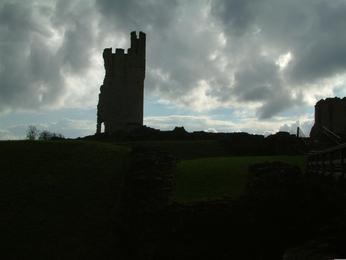
Helmsley – Another splendid market town on the River Rye with the impressive ruined castle overlooking. The remains of a tall tower dominates the skyline. The castle was started in the 1120s by Walter Espec. It was designed with two baileys enclosed by huge earthworks, which remain to this day. It was further embellished throughout the Middle Ages with more 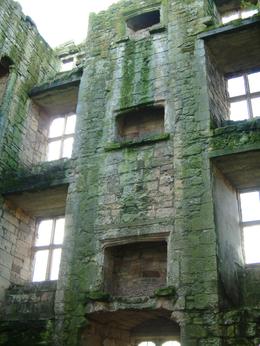 buildings and ever more elaborate defences. In the 16th Century, the medieval buildings were converted into a fine Tudor mansion. However, a large part of the site was destroyed during the Civil War, although it remained a residence until the early 18th Century. A Green Woodpecker flies up from the top of one of the defensive banks. Beyond the bank is Helmsley walled gardens dating from 1758. Feral Pigeons and Jackdaws fly around and settle on the top of the tower. In the shell of the Tudor mansion, there are fireplaces up the wall. On what would have been the third floor, the fireplace is occupied by a substantial nest of twigs – probably an old and much reused Jackdaw nest. We walk on into the town. There is an impressive market place dominated by a statue of Lord Feversham.
buildings and ever more elaborate defences. In the 16th Century, the medieval buildings were converted into a fine Tudor mansion. However, a large part of the site was destroyed during the Civil War, although it remained a residence until the early 18th Century. A Green Woodpecker flies up from the top of one of the defensive banks. Beyond the bank is Helmsley walled gardens dating from 1758. Feral Pigeons and Jackdaws fly around and settle on the top of the tower. In the shell of the Tudor mansion, there are fireplaces up the wall. On what would have been the third floor, the fireplace is occupied by a substantial nest of twigs – probably an old and much reused Jackdaw nest. We walk on into the town. There is an impressive market place dominated by a statue of Lord Feversham.
Rievaulx Abbey – Standing on a hillside of the valley of the River Rye, the abbey is a magnificent ruin. It was founded  in 1132 and the first Cistercian abbey in the north of England. Walter Espec of Helmsley Castle provided the founding community with an endowment, the site of the abbey itself and the vills (an administrative unit which may have been of one or more villages or hamlets) of Griff and Tilstone to the north. The abbey rose to importance during the rule of its third abbot, St Aelred (1147-67). Many of the buildings whose ruins now adorn the hillside were started at this time. When the abbey was suppressed in 1538 there were only 22 monks still in residence. The ruins are dominated by the church and the refectory whose tall walls tower over the much lower remains of the many buildings and rooms that make up a busy ecclesiastical centre. They remain imposing, rising up the hill towards the trees. The visitor centre is at the bottom of the valley. We stand under some magnificent Beeches waiting for the rain to subside. A short rumbling sound nearby is caused by a horse knocking over a part of a dry stone wall. The beast stands there looking slightly bemused by its actions. Large flocks of Rooks noisily rise above the woods that cloak the opposing hillside. We wander up into the ruins. It is easy to imagine what an impressive and imposing site this was at the height of its power. It begins to rain again and a rainbow arches over the end of the ruin.
in 1132 and the first Cistercian abbey in the north of England. Walter Espec of Helmsley Castle provided the founding community with an endowment, the site of the abbey itself and the vills (an administrative unit which may have been of one or more villages or hamlets) of Griff and Tilstone to the north. The abbey rose to importance during the rule of its third abbot, St Aelred (1147-67). Many of the buildings whose ruins now adorn the hillside were started at this time. When the abbey was suppressed in 1538 there were only 22 monks still in residence. The ruins are dominated by the church and the refectory whose tall walls tower over the much lower remains of the many buildings and rooms that make up a busy ecclesiastical centre. They remain imposing, rising up the hill towards the trees. The visitor centre is at the bottom of the valley. We stand under some magnificent Beeches waiting for the rain to subside. A short rumbling sound nearby is caused by a horse knocking over a part of a dry stone wall. The beast stands there looking slightly bemused by its actions. Large flocks of Rooks noisily rise above the woods that cloak the opposing hillside. We wander up into the ruins. It is easy to imagine what an impressive and imposing site this was at the height of its power. It begins to rain again and a rainbow arches over the end of the ruin.
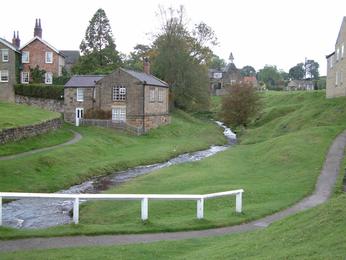
Hutton-Le-Hole – Another village high on the moors. It is divided by a stream flowing through a deep channel surrounded by a wide undulating grassy area. A modern house has, inexplicably, been built on the edge of the open space, looking most incongruous. The Rydale Folk Museum is an excellent collection of traditional Yorkshire buildings representing the types of homes of Yorkshire working people from the Middle Ages onwards. Even the relatively recent Victorian cottage is rudimentary and spartan by our modern day standards. Exhibits range from Stone Age implements to a fully equipped late 19th Century photographic studio. Traditional species of vegetable and flowers are growing in an allotment. Pigs, chickens, geese and sheep are also in the nearby fields.
Rosedale Abbey – We have booked into an hotel at Rosedale Abbey. The village is across the top of the moors. The heather and bracken are now brown and the moors have gaunt and forlorn beauty about then. Rosedale is in a deep glacial valley. Again, the road down is a 1 in 3 descent. It is raining again. The hotel is about three-quarters of the way down the hillside, looking out over the valley. We quickly book in and settle down to a pint of Black Sheep. Dill the Dog, who has been with us around all the sites we have visited, is pretty tired and has not really got the energy to even try to scrounge anything to eat. Dinner, in the bar, features good local produce; Kay has rabbit, I have partridge.
Sunday 19th October – North Yorkshire – During the night, the rain drums down on the roof of our hotel room. It seems to have stopped by the morning. I take Dill the Dog back up the hill – Rosedale Chimney Bank. There is a track heading across the slope. Rabbits race from the field, across the path and into the bracken. Dill the Dog actually notices one and trots over and sticks her nose into the brown depths. Meanwhile many other rabbits take the opportunity to cross the path without her 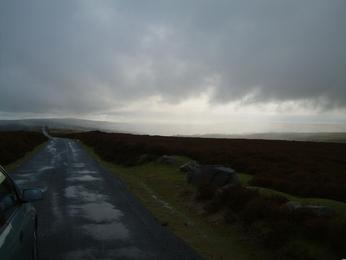 noticing. This happens several times! Water is pouring off the hill into ditches beside the path and through piping out onto the flooded fields. The light brown clay of the hillside is sodden. Over the valley, the other side is a patchwork of fields delineated by dry stone walls and some hedgerows, the maturity of which would indicate these are ancient boundaries. We head up to the top of the hill – by car I am ashamed to admit. Just off the road at the top of the moor is a series of arches. These are the ruins of kilns that were used to process iron ore by driving off water and carbon dioxide – calcification – to make the ore lighter for transportation to the furnaces of Teeside.
noticing. This happens several times! Water is pouring off the hill into ditches beside the path and through piping out onto the flooded fields. The light brown clay of the hillside is sodden. Over the valley, the other side is a patchwork of fields delineated by dry stone walls and some hedgerows, the maturity of which would indicate these are ancient boundaries. We head up to the top of the hill – by car I am ashamed to admit. Just off the road at the top of the moor is a series of arches. These are the ruins of kilns that were used to process iron ore by driving off water and carbon dioxide – calcification – to make the ore lighter for transportation to the furnaces of Teeside. 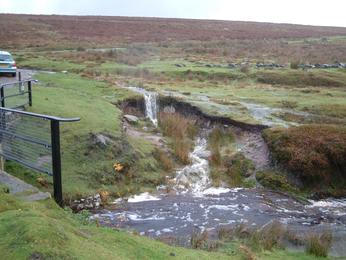 It has begun to rain again and the valley is beginning to disappear into a mist.
It has begun to rain again and the valley is beginning to disappear into a mist.
Whitby – After breakfast we head across the moor towards Whitby. It is still raining and very bleak. Small streams are torrents of water the gurgles down with feeder streamlets coming in from every direction. In one stream a Mountain Ash stands deep in the water being buffeted by the flow. Stone crosses are a feature of the moors and can be seen regularly. As we reach the north-east edge of the plateau, the mist filled valleys glow with the sunlight behind them. We drop down to Egton Bridge and through a rushing ford and on to the main road. Our visit to Whitby is brief. We wander through the old town and buy six pairs of kippers from the smoke house. The Endeavour is back in harbour.

Tuesday 26th October – Home – Not my usual rambling, but a significant enough event to warrant recording. I heard this afternoon that John Peel, the radio DJ, had died whilst in Peru. I first heard Peelie as a teenager, listening to my Baird transistor radio under the covers, when he was broadcasting from midnight from the pirate ship, Radio London. He introduced me to the great bands of the 60s – Captain Beefheart, Love, Jefferson Airplane, The Incredible String Band, The Velvet Underground and so many more. But he never stayed still musically, always  exploring new sounds. In the early 70s, English Folk became electrified and Peelie was the first to play it. He was virtually the only DJ brave enough to support the punk revolution and many of the bands that became iconic from that period started out on the John Peel Show. And so it continued – reggae and African music being featured by Peelie virtually kick-started the World Music scene; early Chicago House music and the new black American music found an outlet on his show. Who knows how many young hopeful young groups started with a Peel Session – ranging from the grindcore noise of metal bands such as Extreme Noise Terror and Napalm Death, through the indy groups such as My Bloody Valentine, Slowdive, Lush, Curve and then into the new DJs playing their mix sets. He was always enthusiastic about people who were trying to produce new music, whilst never forgetting the greats of the blues and rock and roll. I, like many others, will miss him terribly.
exploring new sounds. In the early 70s, English Folk became electrified and Peelie was the first to play it. He was virtually the only DJ brave enough to support the punk revolution and many of the bands that became iconic from that period started out on the John Peel Show. And so it continued – reggae and African music being featured by Peelie virtually kick-started the World Music scene; early Chicago House music and the new black American music found an outlet on his show. Who knows how many young hopeful young groups started with a Peel Session – ranging from the grindcore noise of metal bands such as Extreme Noise Terror and Napalm Death, through the indy groups such as My Bloody Valentine, Slowdive, Lush, Curve and then into the new DJs playing their mix sets. He was always enthusiastic about people who were trying to produce new music, whilst never forgetting the greats of the blues and rock and roll. I, like many others, will miss him terribly.
Saturday 30th October – Fleets Dam – A damp but not really cold morning. Five Grey Herons are around the lake, three on fishing stages, one on top of one of the aerators and one in a tree overlooking the water. A Black-headed Gull circles the lake calling. It is answered by small flocks moving in from the east. A few Tits and Blackbirds are calling. There are a lot of Magpies around, noisy and squabbling.
Home – A dampness hangs around the garden. Slugs are demolishing my courgettes. I hang out freshly charged feeders and put a pile of food on the bird table. Tomatoes are finally ripening in the greenhouse; the outdoor ones came to nothing. There is a lot of digging required but I am not in the mood today.
Sunday 31st October – Old Railway, Worsbrough – The sun filters weakly through the misty haze. Everywhere is wet. Hips and Haws shine red brilliantly. A Redwing flies over. The banks beside the track are a mixture of bramble, dead willowherb, thistle and other plants, but in places they have been completely replaced by stands of Japanese Knotweed. It seems that this invasive plant will eventually colonise the entire area, much to the detriment of wildlife as there seems to be little value in the dead and sterile ground under it. The noise of the M1 motorway is very pervasive this morning, but Blackbirds, Robins and Wrens all call out above the drone of traffic. An Oak stands in a field, golden leaves and broken branches. The banks rise into a cutting. The alarm calls of Partridge come from the fields beyond the cutting and a Sparrowhawk briefly sweeps overhead. A Robin tics angrily from a low branch, bobbing to and fro as it does so.
Dodworth – The grass under an Oak is scattered densely with acorns. There are also several species of fungi here. Lyophyllum descastes has a chocolate brown cap. Descates is Greek for “a company of ten men” and refers to its habit of growing in clumps. It is edible but easily confused with poisonous varieties. The Common White Helvella (Helvella crispa) is a weird specimen. The cap is a curled mass rather than the normal shape. Helvella can been eaten cooked but is poisonous raw. Finally there are a few Wood Blewits (Lepista nuda), which again need cooking to avoid stomach problems. These used to be picked in huge quantities in the Midlands but are little seen commercially today, although they are still very popular on the continent.